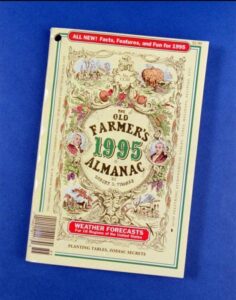
(Photo credit: State Journal archives)
No, not seriously.
There are two publications of a “farmer’s almanac.” “The Old Farmer’s Almanac” has been in publication since 1792. Then there’s the “Farmers’ Almanac,” which has been in publication since 1818.
Both publications contain what is typical of almanacs in general — planting dates, tide tables, various astronomical and astrological information, content typically contained in almanacs. They also offer gardening tips as well as jokes and whimsical columns. These two publications also predict the general weather for the coming year.
Before modern meteorology, almanacs were one of the only ways in which people would receive weather predictions. Our great-great-grandparents probably read the almanac predictions. But we have come a long way in understanding the physics of the atmosphere since the 19th century.
Are the predictions accurate? Rigorous comparison to local or National Weather Service forecasts are difficult. Much like a horoscope, the almanacs’ predictions are as vague as possible so that the forecast can be interpreted as true if you want it to be so.
The method of how the almanacs make a forecast remains a secret and thus cannot be assessed. We suggest you follow the modern forecast methods instead.
Steve Ackerman and Jonathan Martin, professors in the UW-Madison department of atmospheric and oceanic sciences, are guests on WHA radio (970 AM) at 11:45 a.m. the last Monday of each month. Send them your questions at stevea@ssec.wisc.edu or jemarti1@wisc.edu.

